Imagining the Future of the Barbie Dreamhouse
- Social Entrepreneurship
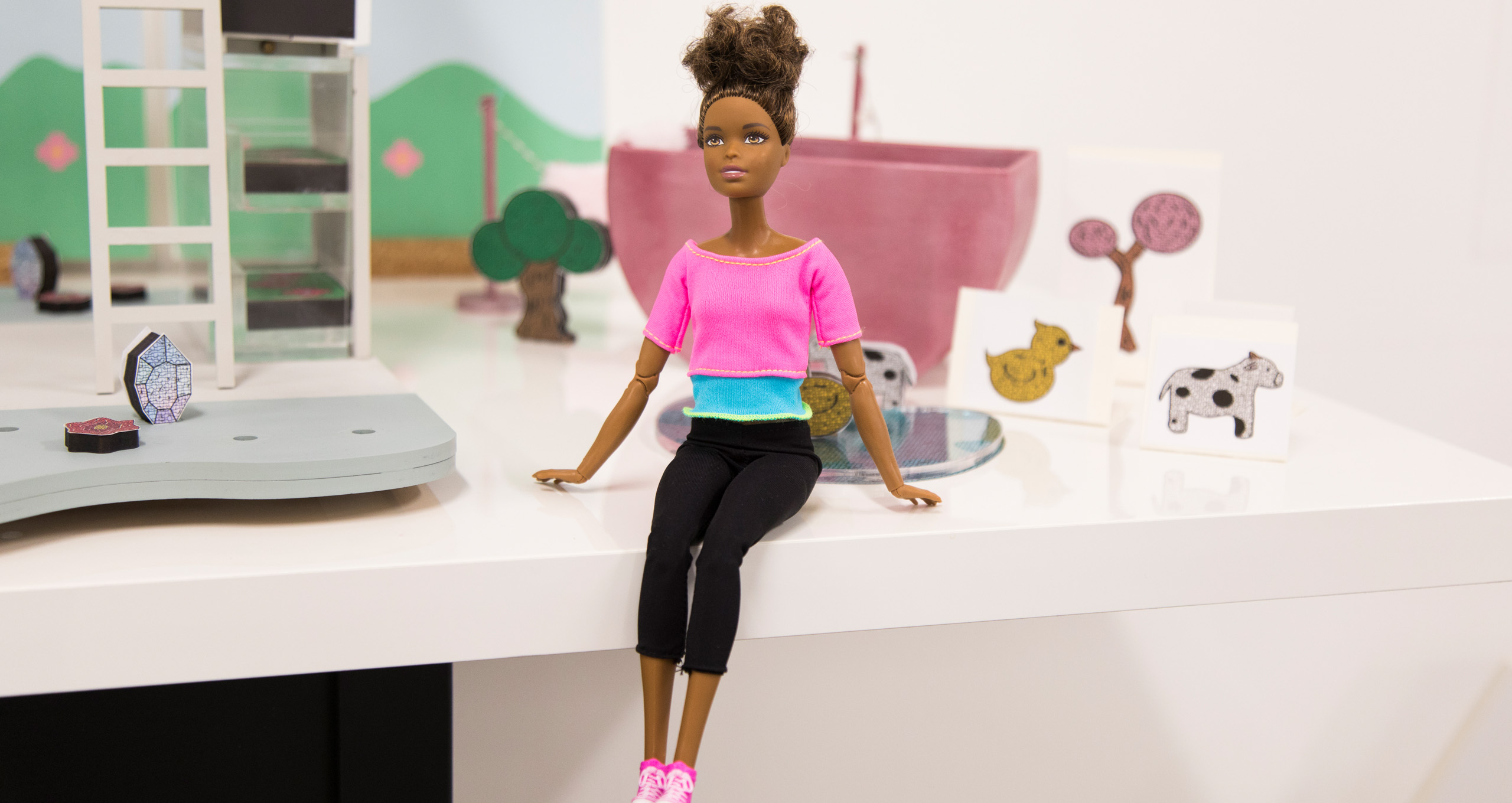
Summer 2017
Imagining the Future of the Barbie Dreamhouse Studio challenged a team of interdisciplinary ArtCenter students to envision innovative forward-thinking ways of reimagining the iconic Barbie Dreamhouse for 2022 by responding to the cultural and societal needs of children around the world while creatively predicting how people will live, work and play in the future.
Students explored the dynamics of play as essential in childhood development through research, noted speakers, and observing focus groups interacting with the current iteration of the Barbie Dreamhouse. Drawing upon their own childhood experiences with toys and games, students imagined how the Dreamhouse could evolve to expand the concept of what home will mean in the future.
Through field exploration, ideation, and prototyping, students thoughtfully considered how Mattel could update the Dreamhouse to create a toy that’s fun to play with and will act as the trend maker of tomorrow, incorporating the possibilities of home in the future as well as encouraging the hopes and dreams of all children.

“So many people wondered about the social impact of this TDS. Barbie and Designmatters? Yes! I see this TDS as a brave and bold endeavor. I am so excited and energized by every brand going through DM now. This reminds me of the book “Responsible Company” by Yvon Chouinard who writes about the experience with Patagonia. While the impact can be what we do, you and I in our daily lives, but the more real impact happens in our role as workers and producers. The Mattels of the world — that’s where we will make a difference. Chouinard says that most of that difference, about 70 percent, happens at the design level. So it’s here, in places like Los Angeles, where we can steer that ship to have a positive social impact in the future. I am so excited.”
– Sherry Hoffman, Senior Educational Liaison, Designmatters
Background: Mattel, Barbie and the Barbie Dreamhouse
Founded in 1945, Mattel is a multinational toy manufacturing company with headquarters in El Segundo. As the world’s largest toy maker, Mattel creates numerous classic and quintessential products that have been beloved by children around the world for generations. Mattel’s portfolio of consumer brands include: Fisher-Price, Hot Wheels, Matchbox, American Girl, Thomas and Friends as well as Barbie. The company has a presence in 40 countries and territories, and sells products in more than 150 nations.
The Iconic Barbie Doll and the Barbie Dreamhouse
As a doll, Barbie was a revolutionary concept introduced in the late 1950s. Prior to its inception, young girls typically played with 2-D paper dolls or infant dolls. Ruth Handler observed her daughter playing with those dolls for hours and convinced her husband Elliot – co-founder of Mattel – to manufacture and offer the first doll in American history in the image of a teenager.
Named after Handler’s daughter Barbara, the doll debuted at New York Toy Fair in 1959. The Handlers then invested all their money to run a television commercial during The Mickey Mouse Club to introduce the doll. The advertisement fueled demand for the fashion doll and sparked the imagination of children who could better identify and project themselves into the glamorous life of an independent teenager. Barbie became more than just a popular play doll; she developed into a role model that reflected society and popular culture.
Beginning with the consumer suburban lifestyle of the 1950s, Barbie iterations have mirrored societal tastes and fashion trends (Malibu Barbie in the 1970s, Rocker Barbie in the 1980s, etc.). Additionally, Barbie came to represent significant social and cultural values about the role of women in the community, workplace and family life. As the women’s movement grew, Barbie redefined aspirational goals for young girls presenting options beyond homemaker and fashion model. Throughout her lifespan, Barbie has been represented in 180 careers including astronaut, veterinarian, paleontologist, and president.
Consequently, the brand has created an extensive line of small and large signature accessories including the Barbie Horse, Barbie Camper, Barbie Car and the Barbie Dreamhouse. Like Barbie, these accessories are updated regularly to match consumer trends as a reflection of the times.
As a cultural icon, Barbie’s influence runs deep in the global psyche. She has appeared on notable magazine covers, been scrutinized as the subject of academic papers, and has been contextualized in various mediums by contemporary artists. Celebrities, sport figures and other high-profile personalities have teamed up with Mattel to create collectible Barbies which continually adds to the brand’s enduring legacy.
In 2016, Barbie introduced three new body types–curvy, petite, and tall, plus a variety of skin tones, hair colors and textures. Introduced to reflect the world girls see today, the new diverse line offers a multicultural play experience for children everywhere.
As a symbol of innovative design and through her many incarnations and product development, Barbie continues to inspire creative self-directed play that can mimic real-life narratives, imagine fantastic scenarios and nurture personal dreams.

“This was my first experience doing a sponsored project and I am incredibly inspired by what I have seen from the ArtCenter students. This studio has been a reminder to me of all the possibilities of this brand and the amazing discipline that we have all chosen for our lives in design and the power behind that possibility and the awesome responsibility to imagine what the future will be. I am extraordinarily impressed with everyone, with the leadership, the faculty and the energy [the students] have put into this. I feel so grateful to be a part of this experience with [the team] collectively and as individuals.”
– Kimberly Culmone, Vice President, Barbie Design
Research and Project Development
Meeting Mattel and the Barbie Dreamhouse
To kick-off the studio, Mattel invited ArtCenter faculty and students to its El Segundo headquarters for an in-depth history and brand overview of Barbie and the Barbie Dreamhouse.
Displays of actual Dreamhouses from 1962 to the present allowed students to see the progression of the product as it relates to not just manufacturing advancements, but also as responses to worldwide cultural dynamics and popular culture.
Students learned that the top-selling Dreamhouse is a heritage item, meaning it is a product that has special association with Barbie because of its long-lasting history and deep connotation to the brand. Other heritage items in the Barbie brand include the Barbie Camper, Barbie Horse and Barbie Car.
Mattel’s Director of Marketing Arnaud Kerviche presented a history of Mattel and its creators Bob and Ruth Handler, discussing how the doll was a symbol of innovation and design that also inspired creative, open-ended play.
Emily Williams of Mattel’s Global Consumer Insights gave an in-depth discussion on the way young girls typically play and how Mattel utilizes focus groups in their product development and brand strategy.
Williams offered an overview of the developmental play patterns of young girls which corresponds to how they play with Barbie, her accessories and her world. Williams also shared the storytelling patterns for girls, which involved family reenactments (routines, day-to-day events with key rooms being the bedroom, bathroom and kitchen) and interacting with friends (hanging out, having parties, playing in a pool, getting snacks for the party with key rooms being the kitchen, bedrooms, living room and outdoor pool areas).
Students learned that often times the organizational set-up of the Dreamhouse is just as engaging as the actual stories told.
Mattel designer and Barbie aficionado Bill Greening gave a history of Barbie, noting how the doll’s updates correspond to pop culture and fashion trends. Greening shared prominent changes in the doll through the decades, highlighting major developments such as the addition of Malibu Barbie in 1970s, Rocker Barbie of 1980s and the Fashionista Barbie of the 2010s.
Greening pointed out that today’s Barbie is a cross-platform brand; the doll is featured on an animated YouTube series “Barbie, Live in the Dreamhouse,” and the brand has an active social media presence.
Dreamhouse Designer and ArtCenter alumna Esther Levine offered students an in-depth look at the evolution of Dreamhouse through the years, charting the development from a simple cardboard, one-room structure to the current vertical, pink plastic townhouse style complete with interactive sound and light additions. In addition to the large format structures, the Dreamhouse is also available in smaller, compact fold-up, play and go formats.
Finally, the Mattel team shared reoccurring desirable themes that Dreamhouse designers know to be appealing to consumers:
- Water features such as pools, fountains and bathtubs
- A large scale structure with multiple stories
- Elevators
- Space for everyone – friends, family and pets
- Whimsical features such as secret passageways, slides, game room, dance room
- Accessories
- Humor – hearing the toilet flush and other unexpected sounds
Research and Development
After digesting the wealth of information and materials presented at the Mattel kickoff, students delved into toy play/behavioral research on their own and through insights from guest speakers.
These subject matter experts offered key insights and takeaways which helped inform the students on the topic of childhood psychology and the importance of play in a child’s development growth. Speakers included:
- Michael Shore, Vice President and Head of Global Consumer Insights and Foresights at Mattel;
- Hawani Negussie, Assistant Professor of Early Childhood Education at Brandman University;
- Doctor Carlene Fider, faculty at Pacific Oaks College.
Students researched today’s toy trends: hands-on, eco-social, gender-neutral, diversity, sustainability, customizable and technology that includes virtual and augmented reality.
Ideation needed to incorporate the physical Barbie doll into their thinking since Barbie lives at the Dreamhouse. Students’ Dreamhouses needed to feel as part of the Barbie brand and be a place where Barbie is integral to the design and concept.
Students tapped into Mattel resources including an opportunity to observe focus group interactions at Mattel’s Imagination Center. Additionally, many students engaged in their own field testing research of initial prototypes and/or concepts.
Early assignments were tailored to connect to student’s own childhood play patterns; these early experiences could help shape and define their conceptual ideas. Students crafted a vision board containing their personal ideas of home as well as projecting how the concept of home could be actualized in the future. Students also designed mobiles to represent childhood and an ecosystem of play that would present images of what that play would look like.
Brainstorming sessions yielded numerous “mild to wild” What ifs?, which were collected on Post-its and later clustered for themes and concepts to consider.
A workshop with Elizabeth Chin, ArtCenter faculty in Media Design Practices, presented students with a deeper understanding of purchasing power from a global perspective which also included a discussion on varying cultures, consumerism, and youth experience – all aspects to consider when designing a product that could be bought and used by children around the world.
Working on their individual and independent prototypes, students often cross-pollinated with their fellow classmates, offering each other suggestions and strategic advice.
Midterm and Beyond
At midterm, students presented their mood boards, industry profiles and rough prototypes that sketched out their ideation to the Barbie team. Barbie representatives provided generous feedback and concrete suggestions on how each student could push their concepts forward; the Barbie team challenged the students to reflect what makes their Dreamhouse special and to narrow their focus to that one unique element. The team inspired students to elevate their thinking to fantastic heights, dialing up the “WOW” factor about life in 2022.
To help visualize the near-future, students participated in a classroom workshop based on the 2014 The Thing From the Future, an imagination game created by Stuart Candy and Jeff Watson of the School of Art Institute of Chicago. ArtCenter faculty adapted part of the framework of the award-winning game into a forward-thinking worksheet. Students considered the question: “Who are you designing for?” followed by constructing three quick prototypes that would simply and accurately illustrate their answers.
From there, students were paired with a classmate (based on their individual project themes) so they could offer new insights and feedback to each other. The ultimate goal was to have a one sentence mission statement for each project about what the future will be like; students would refer back to this sentence making sure their execution delivered on their initial intent and essence.
Students continued refining and re-envisioning their concepts, checking-in with the Barbie team for any additional suggestions, advice and encouragement before their final presentations.
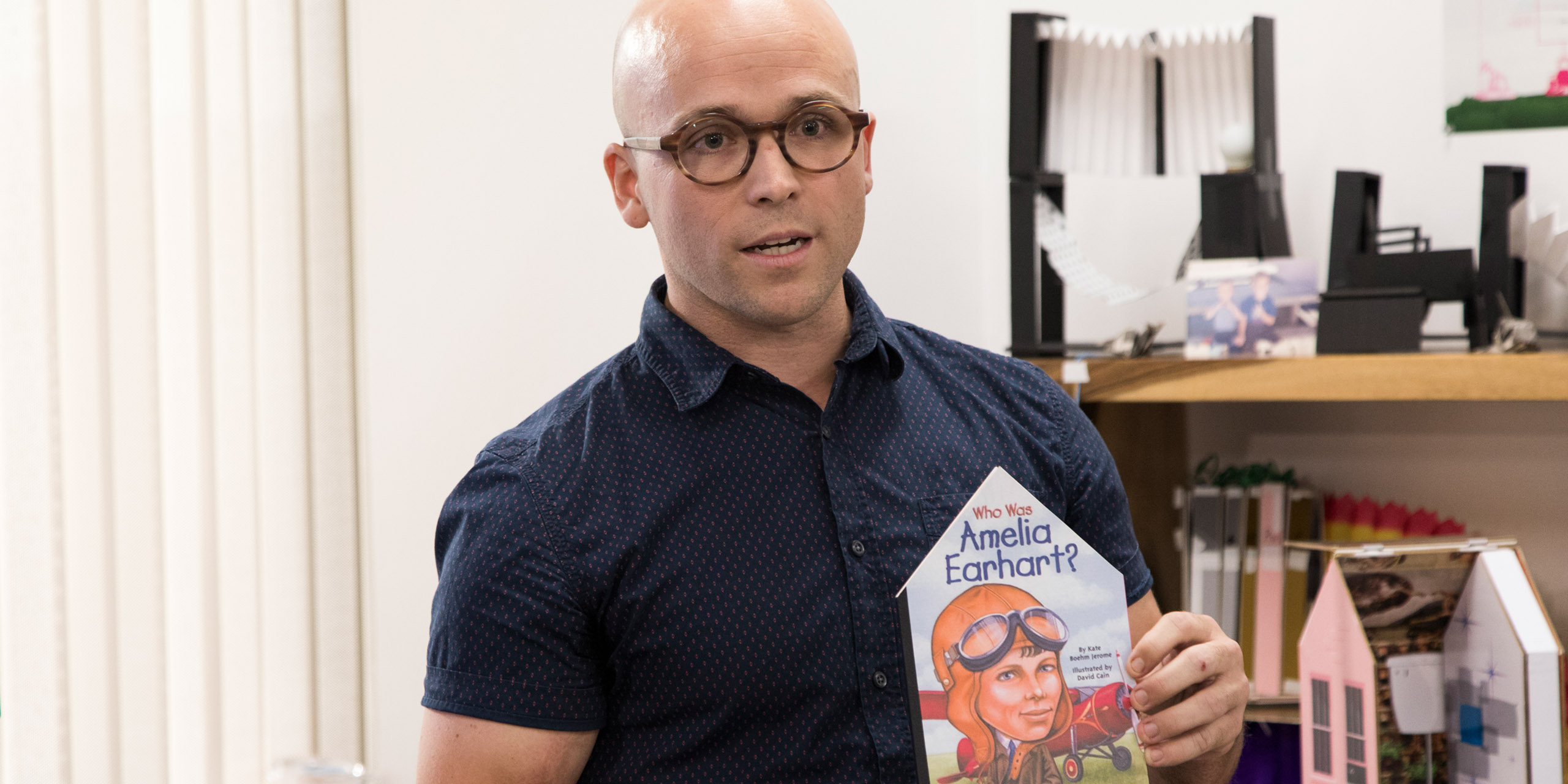
“I was not expecting to fall in love with the project as I had. I was really excited by the teachers – they are a captivating and intelligent, creative and empathetic group. I was open to the idea of Barbie but there was never that pull from my childhood. But I guess you could call me a convert. Reflecting culture and predicting culture was awesome. And thinking about the responsibility of the brand and what it can say about users and behavior and expectations. It was very eye-opening.”
– Charlie Hodges, Student, Product Design
Student Projects
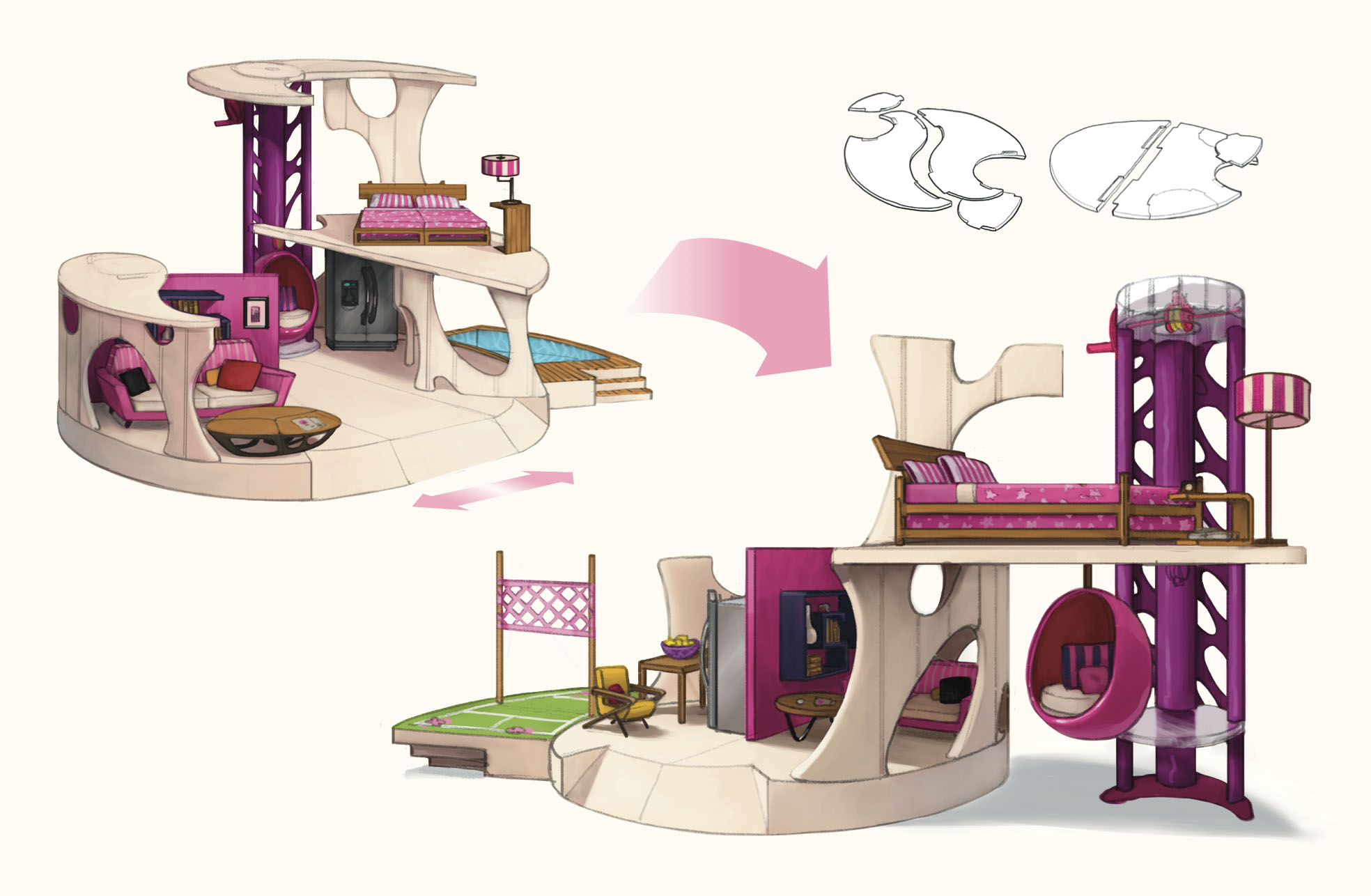 close
close
Build and Dreamhouse
Read moreCarson Brown
“In 2022, Barbie will encourage children to learn skills through play.” Many young girls are interested in engineering and technology but are often excluded in those roles in adulthood. Empowering girls to embrace their passion through play, this modular futuristic-looking Dreamhouse encourages girls to imagine and invent a customizable structure. The flexible system does away with the confines of a typical playhouse; here walls, floors and accessories can be removed, added or altered as desired. Players can build vertically or horizontally. Pieces are easily interchangeable with an organic feel. Building and designing the Dreamhouse becomes play in itself.
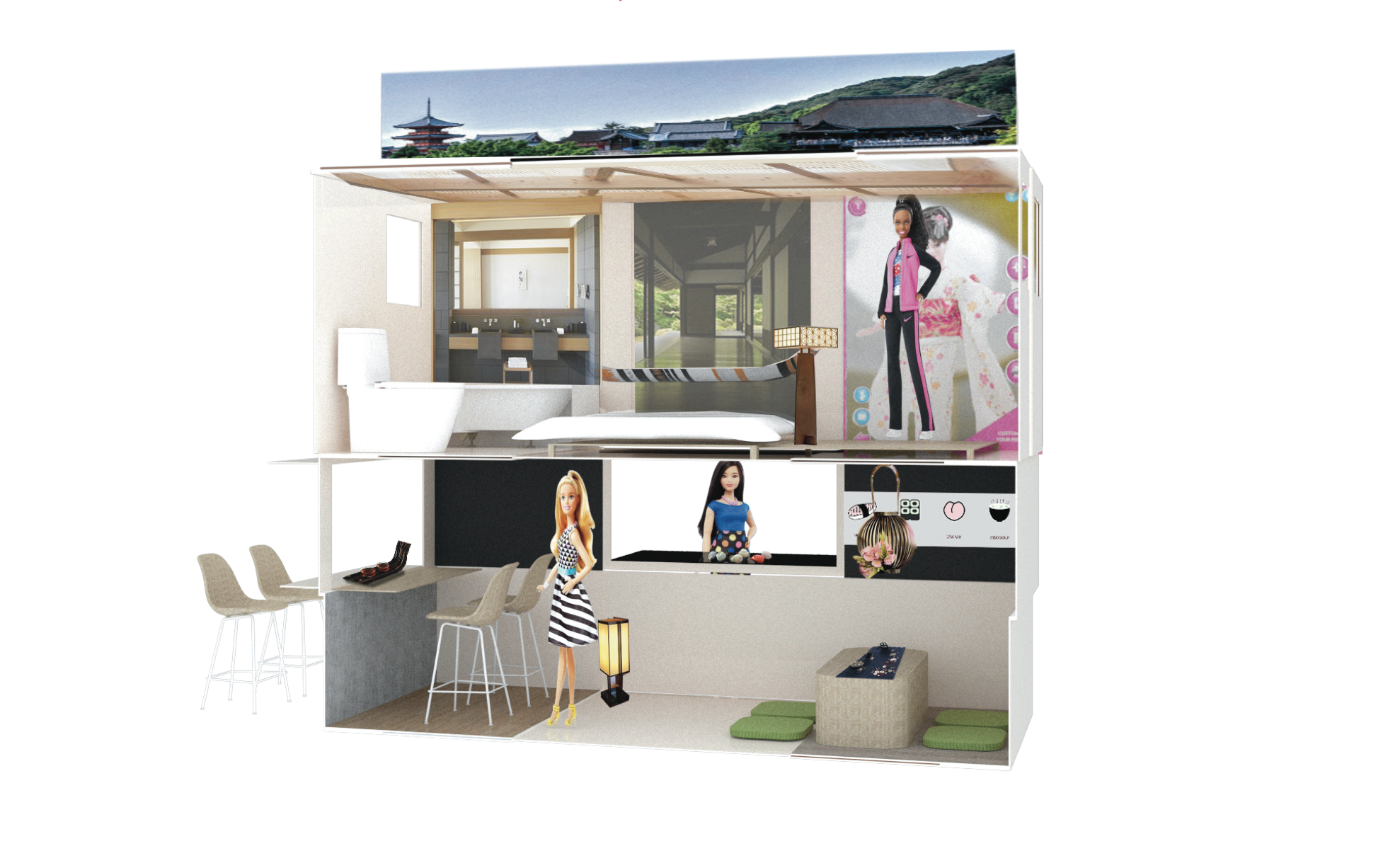 close
close
Barbie Dreamhouse for the Future
Read moreTanya Cai and Yeling Guo
“In 2022, Barbie’s Dreamhouse will be a window to show global cultural diversity.” This Dreamhouse – in the shape of a suitcase – symbolizes a near future where families frequently connect on a global scale through the internet, travel, and international employment opportunities. Youngsters customize their Dreamhouse play experience by choosing a specific ethnic group and an associated festival (Japan: Tea Ceremony, India: Holi, America: Christmas, etc.). Downloading an app digitally transforms their Dreamhouse walls and closets into that specific cultural experience. Children manipulate Barbie who creates ethnic dishes, puts on cultural costumes and engages in traditional celebrations of art, dance and music. The Dreamhouse’s communal-designed, tri-level floorplan reflects the shared public multicultural living of the near future.
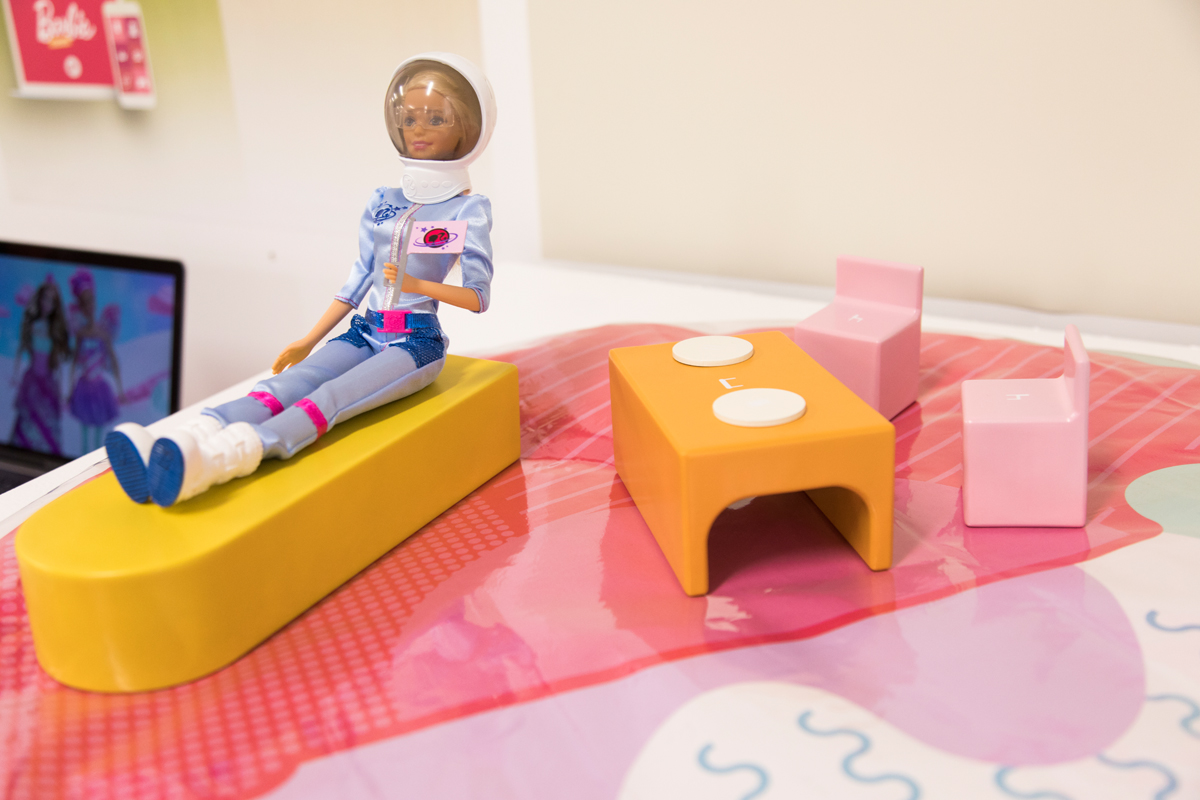 close
close
Creator Barbie
Read moreEcho Cho
“In 2022, Barbie will empower every kid through digital technology.” This Dreamhouse combines technology with a physical tactile toy that allows kids to create stop-motion, animated storylines which can be shared through social media. This virtual Dreamhouse consists of props and a play mat; through a digital device (laptop/notebook) children decide which location will be the setting for their open-ended play. Sensors in the props and play mat correspond to the computer prompt to create the requested scene. Props are designed to represent a variety of accessories adding to the limitless potential. Children can manipulate and capture the storytelling as they engage with others online in a shared community of play.
 close
close
Barbie Dreamscape
Read moreSarah Ellis
“Barbie is where the past, present and future meets.” Targeting the nomadic lives of families with children of the future – especially those in the armed forces – this Dreamhouse invokes memory and personal experiences into the play space. Easy to carry and with a compact grab-and-go design, the Dreamhouse is a simple folded cardboard structure that will be affordable to many families. Children – and/or their parents – can personalize the play rooms by sending images, photos and themed suggestions to Mattel that will create unique backdrop stickers to be affixed in the Dreamhouse play rooms. Children can easily carry with them a replica of their old bedroom, playroom, etc. as a reminder that home is where your heart is.
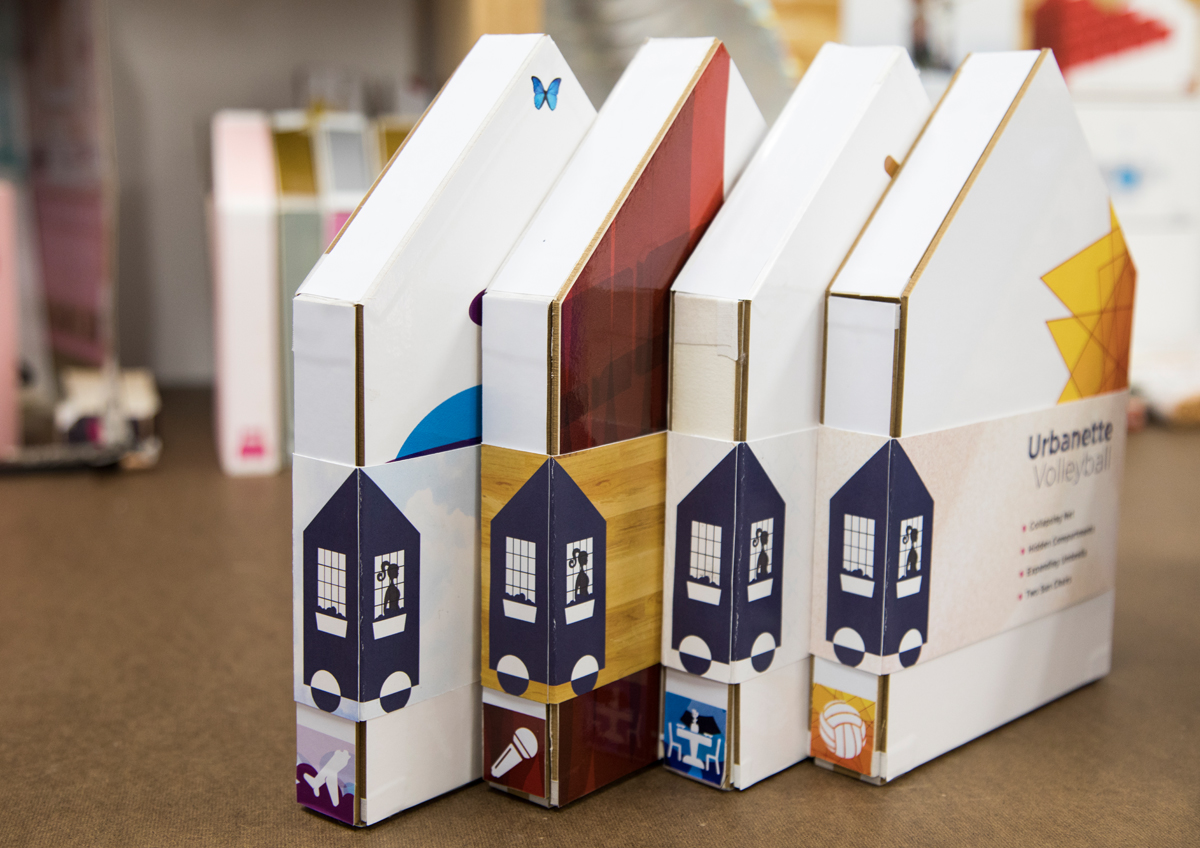 close
close
Barbie Dream Urbanette
Read moreCharlie Hodges
“Life in 2022: Bikes and pedestrian pathways abound. Lifestyles are mobile and customized. Self-expression is a preferred currency. And sustainability is a normal way of life.” A modular eco-friendly doll house, the Dream Urbanette comes in a traditional house-shaped carrying container on rolling wheels and is customizable for a child’s interest. This analogue and inexpensive Urbanette is augmented with whimsical and themed-room elements; four are part of the original purchase, but additional rooms/experiences can be ordered at any time. Unfolding and assembling the main house structure is an engaging experience for young and old. Room additions contain clever and surprising fold-out accessories and items that enhance the play environment for Barbie. Children can engage in solitary or communal play, sharing pieces and storytelling.
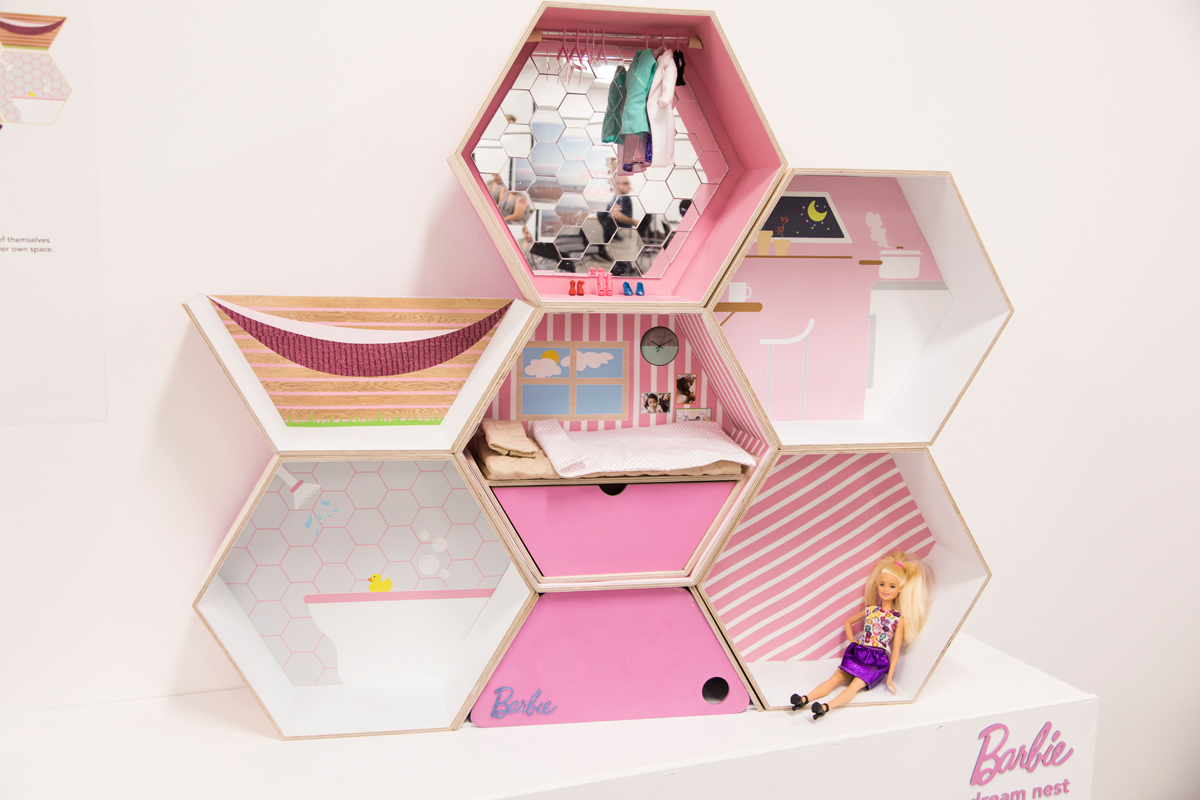 close
close
Barbie Dream Nest
Read moreJulia Kim
“In 2022, Barbie is used as a tool for girls to express themselves; home is the first place where that happens. Home is a safe place where they can be themselves.” Young children can create their own personalized Dreamhouse by easily connecting together a series of open-sided hexagonal shapes that represent rooms and living spaces. Made of polypropylene and plywood, the modular structures contain LCD display screens which allow players to choose backdrops and accessories to change the play landscape. Additionally, photos can also be uploaded from smart phones (personal pets, favorite toy items, etc.) to further add to the customization of the Dreamhouse. Players can save or reset digital room designs at any time. Solo players can invite friends over with their Dreamhouses to create a larger, communal play with unique configurations.
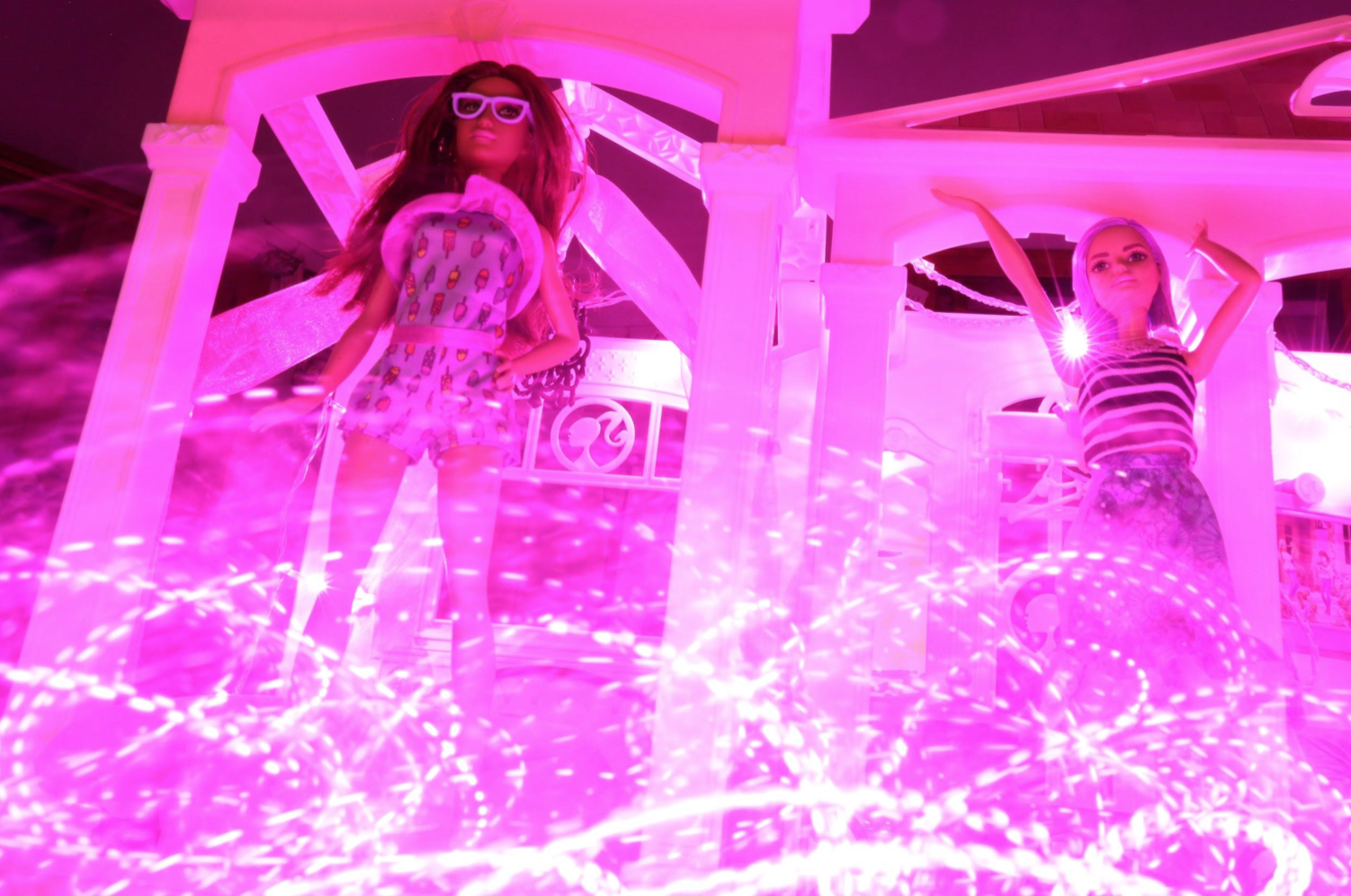 close
close
RÊVE Music Barbie
Read moreDouglas Krantz
“In 2022, music will be a part of every child’s day-to-day life because music will be everywhere – a connection between digital and analog medic will move music into an all-encompassing experience.” Tapping into the emotional power of music and its importance in early childhood development, this Dreamhouse expands the use of lights/sounds in the current Dreamhouse by adding fun and sensory experiences for imaginative Barbie play. The conventional Living Room becomes a Rhapsody Space where kids (through Barbie) can experiment mixing together digital sounds in a party-like atmosphere. The garage, now the Melody Space, is where Barbie and her band friends can practice and perform using real instrument sounds. Resonance Space upgrades the former kitchen where Barbie can experience unconventional sounds while cooking and playing.
 close
close
Barbie Dream Farm House
Read moreAngelina Shin
“The 2022 forecast is a Tiny House Lifestyle where experiences are valued more than possessions, especially living with nature.” Children simulate a self-sufficient lifestyle with this Dreamhouse that combines the inspiration of the Tiny House movement with Augmented Reality (AR) technology. Through Barbie, children can build their own world in this tactile toy. Through AR imaginary, they cultivate crops, control the weather and feed/nurture the animals in their care. Encouraging communal play with friends, when new Barbies are introduced into the Dreamhouse, special fruits and vegetables are unlocked via AR; animals that eat these special items gain magical powers with silly surprises, such as flying pigs.
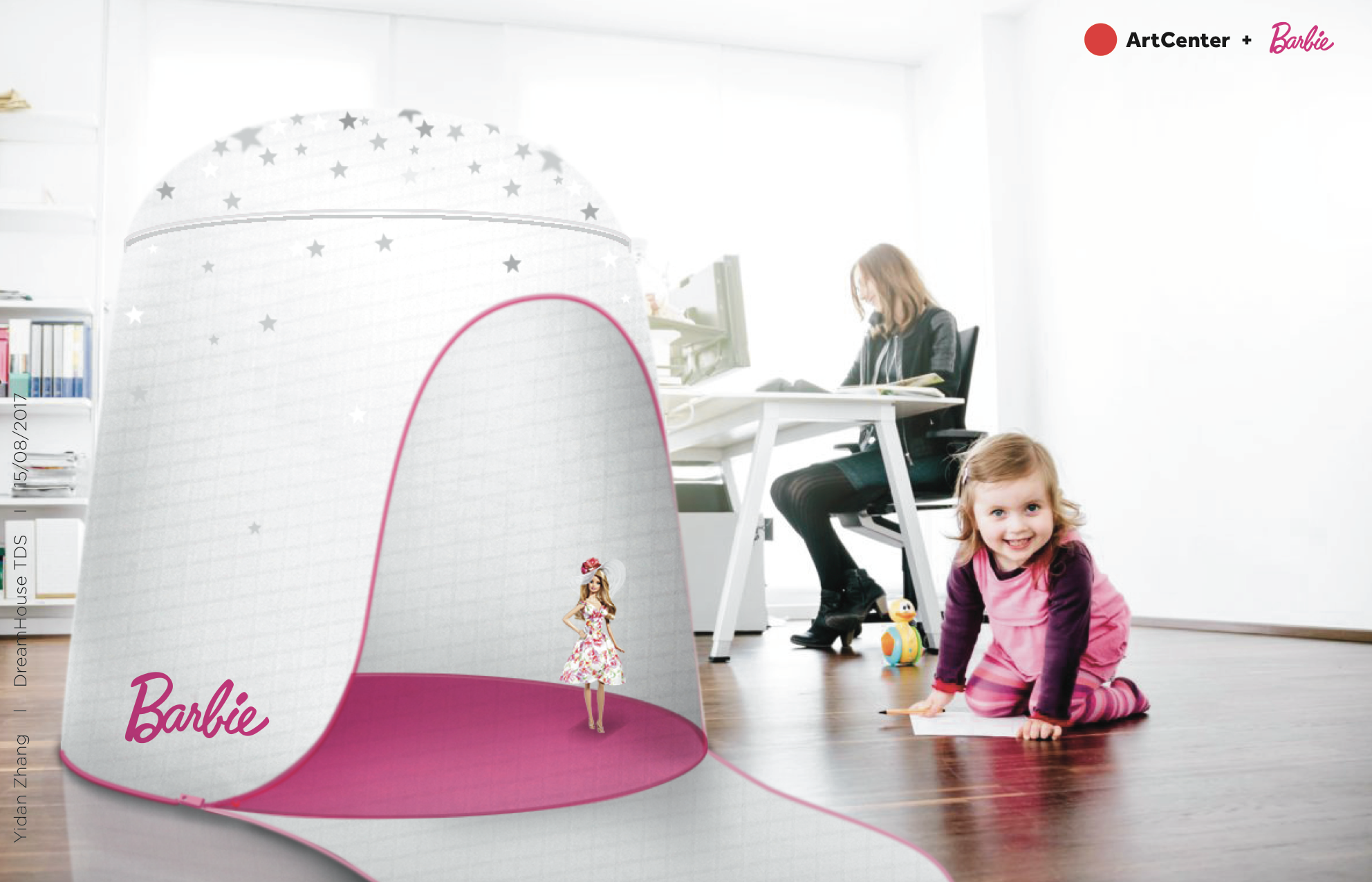 close
close
Barbie Dream Pod
Read moreYidan Zhang
“In 2022, families will primarily be single child units.” The Barbie Dream Pod is an immersive solo play experience that puts the young player physically inside Barbie’s house. Combining pop-up tent designs with projection technology, the Dream Pod is a personal space where children can engross themselves in a seamless and otherworldly play narrative. Portable to any location, girls can imagine a variety of scenarios (outer space, wilderness camping, etc.) via the digitally accessed backdrop/landscape. Whimsically designed accessories and furniture items are packaged in play kits; these additions are made of lightweight fabric and are easy to assemble and affix on the walls of the Dream Pod.
Publication
-
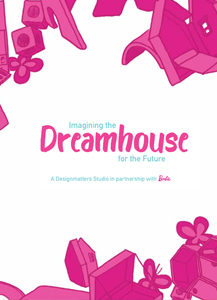
-
Imagining the Dreamhouse for the Future: A Designmatters Studio in Partnership with Barbie
This book documents the Imagining the Future of the Barbie Dreamhouse Studio in which a team of interdisciplinary ArtCenter students were challenged to envision innovative forward-thinking ways of reimagining the iconic Barbie Dreamhouse for 2022 by responding to the cultural and societal needs of children around the world while creatively predicting how people will live, work and play in the future.
Designed by Judy Torretti
Illustrated by Carson Brown
Published by Designmatters
Download PDF
Video Content
“One of the risks we took was balance that social driver with the “Wow” and the big expectation for this brand. We all wanted this brand to be a change agent in the future through the student voices. Typically we pair two, three people up from the very beginning. But the students brought something magical to the table at Day 1 which was very specific points of view. We have never worked so hard in 14 weeks to make sure that we see that point of view at the end, along with the social impact, and along with the big Wow.”
– Karen Hofmann, Chair, Product Design
“Being from both sides –an ArtCenter alum and Mattel as my home for such a long time, I am so happy today. Designmatters brought in the passion and the thinking and breaking walls. I’m glad that the students stayed true to themselves … You want design to be more socially open, more inclusive, more material-friendly. I am humbled, inspired and grateful for this experience.”
– Esther Levine, Senior Staff Designer, Mattel



